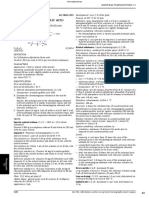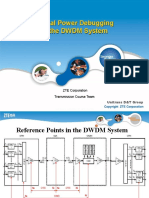Cceptance Criteria in Thbstances
Cceptance Criteria in Thbstances
Uploaded by
qclab.lhplCopyright:
Available Formats
Cceptance Criteria in Thbstances
Cceptance Criteria in Thbstances
Uploaded by
qclab.lhplCopyright
Available Formats
Share this document
Did you find this document useful?
Is this content inappropriate?
Copyright:
Available Formats
Cceptance Criteria in Thbstances
Cceptance Criteria in Thbstances
Uploaded by
qclab.lhplCopyright:
Available Formats
General Information
General Information
New Expression of Acceptance Criteria
in the Test for Related Substances
For information of the stakeholders
In European Pharmacopoeia monographs, the acceptance criteria for related substances have so far usually been
expressed in terms of comparison of peak areas (“… not more than the area of the principal peak in the chromatogram
obtained with reference solution …”), which, strictly speaking, leads to a pass/fail decision but not to a true quantitative
test result.
As the requirements for related substances in Ph. Eur. monographs have been adapted to the principles of ICH Guideline
Q3A(R2) and VICH Guideline 10, many users have requested to apply a similar format for the expression of the acceptance
criteria in Ph. Eur. monographs. An enquiry was published in Pharmeuropa 22.2.
Based on the feedback of the enquiry, it has been decided:
• to apply the new expression of acceptance criteria by numerical values for new monographs and major revision
projects, wherever possible;
• to maintain existing monographs in comparative style until they undergo a major revision.
The way of expressing the criteria will not have any impact on the validity of the test as such. Respective statements to this
end will be added to the General Notices and chapter 5.10. Control of impurities.
Stakeholders and groups of experts will be asked to apply the following style model when drafting or submitting text
proposals.
Related substances. Liquid chromatography (2.2.29). Carry Time (min) Mobile phase A Mobile phase B
out the test protected from light. (per cent V/V) (per cent V/V)
Solvent mixture: water R, methanol R (10:90 V/V). 0–3 60 40
Test solution. Dissolve 50.0 mg of the substance to be 3 – 16 60 49 40 51
examined in the solvent mixture and dilute to 50.0 mL with
the solvent mixture. Flow rate: 1.2 mL/min.
Reference solution (a). Dilute 1.0 mL of the test solution to Detection: spectrophotometer at 238 nm.
100.0 mL with the solvent mixture. Dilute 1.0 mL of this Injection: 10 μL.
solution to 10.0 mL with the solvent mixture.
Identification of impurities: use the chromatogram
Reference solution (b). Dissolve 10 mg of modelon for peak supplied with modelon for peak identification CRS and
identification CRS (containing impurities C, D and F) in the chromatogram obtained with reference solution (b)
the solvent mixture and dilute to 10.0 mL with the solvent
to identify the peaks due to impurities C, D and F; use the
mixture.
chromatogram obtained with reference solution (c) to
Reference solution (c). Dissolve 5.0 mg of modelon identify the peak due to impurity B.
impurity B CRS in the solvent mixture and dilute to 50.0 mL
Relative retention with reference to modelon
with the solvent mixture. Dilute 1.0 mL of the solution to
(retention time = about 6 min): impurity C = about 0.4;
100.0 mL with the solvent mixture.
impurity G = about 0.8; impurity D = about 0.9;
Column: impurity F = about 1.2; impurity B = about 1.9.
— size: l = 0.10 m, Ø = 4.0 mm; System suitability: reference solution (b):
— stationary phase: octadecylsilyl silica gel for
— resolution: minimum 2.5 between the peaks due to
chromatography R (5 μm).
impurity D and modelon; minimum 1.5 between the
Mobile phase: peaks due to modelon and impurity F.
— mobile phase A: mix 10 volumes of acetonitrile R and 90 Calculation of percentage contents:
volumes of a 0.68 g/L solution of potassium dihydrogen
phosphate R previously adjusted to pH 5.0 with 0.5 M — for impurity B, use the concentration of impurity B in
potassium hydroxide R; reference solution (c);
— mobile phase B: mix equal volumes of acetonitrile R and — for impurity C, multiply the peak area by the correction
a 0.68 g/L solution of potassium dihydrogen phosphate factor 1.5;
R previously adjusted to pH 5.0 with 0.5 M potassium — for impurities other than B, use the concentration of
hydroxide R; modelon in reference solution (a).
© PHARMEUROPA Vol. 23 No. 2, April 2011 259
General Information
Limits: Other detectable impurities (the following substances would,
— impurity B: maximum 0.3 per cent; if present at a sufficient level, be detected by one or other of
the tests in the monograph. They are limited by the general
— impurity C: maximum 0.2 per cent;
acceptance criterion for other/unspecified impurities and/or
— impurity D: maximum 0.15 per cent; by the general monograph Substances for pharmaceutical
— unspecified impurities: for each impurity, maximum use (2034). It is therefore not necessary to identify these
0.10 per cent; impurities for demonstration of compliance. See also 5.10.
— total: maximum 0.6 per cent; Control of impurities in substances for pharmaceutical use):
— reporting threshold: 0.05 per cent. E, F, G, H, I.
IMPURITIES
Specified impurities: B, C, D.
260 © PHARMEUROPA Vol. 23, No. 2, April 2011
You might also like
- Harrison Floyd's Opposition To Motion To Quash SubpoenasDocument80 pagesHarrison Floyd's Opposition To Motion To Quash Subpoenaskmoncla100% (3)
- Rivaroxaban Tablets Pharmeuropa 31.02EDocument4 pagesRivaroxaban Tablets Pharmeuropa 31.02EMariaNo ratings yet
- Exercices - BasinsDocument9 pagesExercices - BasinsAysel YusifovaNo ratings yet
- Experimental approaches to Biopharmaceutics and PharmacokineticsFrom EverandExperimental approaches to Biopharmaceutics and PharmacokineticsNo ratings yet
- Intuition Activation ToolkitDocument30 pagesIntuition Activation Toolkitxxdrivexx100% (12)
- PROPOFOLDocument3 pagesPROPOFOLArtem KulikovNo ratings yet
- AprepitantDocument2 pagesAprepitantNguyen Van ThaoNo ratings yet
- Fentanyl CitrateDocument2 pagesFentanyl CitrateMulayam Singh YadavNo ratings yet
- EP10Document2 pagesEP10Nhan MyNo ratings yet
- Warfarin SodiumDocument2 pagesWarfarin SodiumaymenbiogalenicNo ratings yet
- Methyl Hydroxybenzoate - BP2022Document5 pagesMethyl Hydroxybenzoate - BP2022angela.evansNo ratings yet
- β AcetyldigoxinDocument4 pagesβ AcetyldigoxinaymenbiogalenicNo ratings yet
- ParacetamolDocument2 pagesParacetamolSơn HoàngNo ratings yet
- Warfarin Sodium ClathrateDocument2 pagesWarfarin Sodium ClathrateaymenbiogalenicNo ratings yet
- Zanamivir HydrateDocument2 pagesZanamivir HydrateTiago Luiz TortellaNo ratings yet
- VigabatrinDocument2 pagesVigabatrinaymenbiogalenicNo ratings yet
- DiacereinDocument3 pagesDiacereinMulayam Singh Yadav0% (2)
- MetoprololDocument3 pagesMetoprololIli MarinaNo ratings yet
- Betiatide For Radiopharmaceutical PreparationsDocument2 pagesBetiatide For Radiopharmaceutical PreparationsJoceline Estefania Rangel VelazquezNo ratings yet
- FLUOROURACILDocument2 pagesFLUOROURACILArtem KulikovNo ratings yet
- Tranexamic AcidDocument4 pagesTranexamic AcidJagdish ChanderNo ratings yet
- Cefepime Dihydrochloride MonohydrateDocument3 pagesCefepime Dihydrochloride MonohydrateMulayam Singh YadavNo ratings yet
- Rutoside Trihydrate: Time (Min) Mobile Phase A (Per Cent V/V) Mobile Phase B (Per Cent V/V)Document3 pagesRutoside Trihydrate: Time (Min) Mobile Phase A (Per Cent V/V) Mobile Phase B (Per Cent V/V)Artem KulikovNo ratings yet
- Eplerenone (2765)Document2 pagesEplerenone (2765)Mulayam Singh YadavNo ratings yet
- Ibuprofen (Pharmacopoea)Document3 pagesIbuprofen (Pharmacopoea)Titis Adisti HapsariNo ratings yet
- Phenylephrine Hydrochloride BPDocument4 pagesPhenylephrine Hydrochloride BPJai MurugeshNo ratings yet
- ZopicloneDocument2 pagesZopicloneaymenbiogalenicNo ratings yet
- Cetirizine Dihydrochloride 1084eDocument2 pagesCetirizine Dihydrochloride 1084eSurya Teja SeelojuNo ratings yet
- 2.4.24. Identification and Control of Residual SolventsDocument5 pages2.4.24. Identification and Control of Residual SolventswilNo ratings yet
- Ziprasidone Mesilate TrihydrateDocument2 pagesZiprasidone Mesilate TrihydrateaymenbiogalenicNo ratings yet
- ClonazepamDocument1 pageClonazepamLaurentiu DinuNo ratings yet
- Pantoprazole sodium sesquihydrate EP 9.6Document2 pagesPantoprazole sodium sesquihydrate EP 9.6Hung QuangNo ratings yet
- Enrofloxacin For Veterinary UseDocument3 pagesEnrofloxacin For Veterinary Usenguyentuanson167No ratings yet
- Fenofibrate EP 11.0Document2 pagesFenofibrate EP 11.0noschNo ratings yet
- Ambroxol Hydrochloride: Ambroxoli HydrochloridumDocument2 pagesAmbroxol Hydrochloride: Ambroxoli HydrochloridumANDERSON MNo ratings yet
- Etonaol Test Metodu EP Monogarfı 20424EDocument5 pagesEtonaol Test Metodu EP Monogarfı 20424EVeysel KocabeyNo ratings yet
- Fludarabine PhosphateDocument3 pagesFludarabine PhosphateMulayam Singh YadavNo ratings yet
- PH - Eur. Acid UrsodeoxycolicDocument2 pagesPH - Eur. Acid UrsodeoxycolicGrigoras InaNo ratings yet
- FentanylDocument2 pagesFentanylMulayam Singh YadavNo ratings yet
- Meloxicam: Substance MRM Channels Collision Energy (Ev) For The Interval 0-25 MinDocument3 pagesMeloxicam: Substance MRM Channels Collision Energy (Ev) For The Interval 0-25 MinLuciana ParaschivNo ratings yet
- Rosuvastatin EP MonographRosuvastatin EP MonograpDocument7 pagesRosuvastatin EP MonographRosuvastatin EP MonograpNakita Eka Putri100% (2)
- Verapamil HydrochlorideDocument3 pagesVerapamil HydrochloridemicrobiologialeaNo ratings yet
- Keto Prof enDocument2 pagesKeto Prof enpipisoseticaNo ratings yet
- AbcdDocument2 pagesAbcdKhotibul UmamNo ratings yet
- Felodipine: FelodipinumDocument2 pagesFelodipine: FelodipinumIoana-Alexandra Lungu-NastaseNo ratings yet
- Rosuvastatin EP MonographDocument7 pagesRosuvastatin EP MonographJagdish Chander86% (7)
- Wa0011.Document1 pageWa0011.Khotibul UmamNo ratings yet
- Fluconazole - European Pharmacopoeia 10.0Document4 pagesFluconazole - European Pharmacopoeia 10.0Maxim TatianaNo ratings yet
- NitrazepamDocument2 pagesNitrazepamĐoàn DươngNo ratings yet
- Triamcinolone Acetonide EuropeaDocument2 pagesTriamcinolone Acetonide EuropeaMarcela Gomez100% (1)
- Paracetamol TabletsDocument5 pagesParacetamol Tabletslucychamber1990No ratings yet
- Vindesine SulfateDocument2 pagesVindesine SulfateaymenbiogalenicNo ratings yet
- FluconazoleDocument2 pagesFluconazoleMulayam Singh YadavNo ratings yet
- Benzene Residual Solvent MethodDocument9 pagesBenzene Residual Solvent MethodNishit PatelNo ratings yet
- Ethanol, AnhydrousDocument2 pagesEthanol, AnhydrousMiroslav IlicNo ratings yet
- Zoledronic Acid MonohydrateDocument2 pagesZoledronic Acid MonohydrateaymenbiogalenicNo ratings yet
- VoriconazoleDocument2 pagesVoriconazoleaymenbiogalenicNo ratings yet
- FluoxetineDocument7 pagesFluoxetineNatali CecanNo ratings yet
- Charged Aerosol Detection for Liquid Chromatography and Related Separation TechniquesFrom EverandCharged Aerosol Detection for Liquid Chromatography and Related Separation TechniquesPaul H. GamacheNo ratings yet
- Practical Manual of Analytical ChemistryFrom EverandPractical Manual of Analytical ChemistryRating: 4.5 out of 5 stars4.5/5 (3)
- Chemesthesis: Chemical Touch in Food and EatingFrom EverandChemesthesis: Chemical Touch in Food and EatingShane T. McDonaldNo ratings yet
- First Things First ManifestoDocument5 pagesFirst Things First ManifestoGiliam GanzevlesNo ratings yet
- Actividades de Verano 3º Eso Lengua InglesaDocument16 pagesActividades de Verano 3º Eso Lengua InglesaJuan Jesús Pesado del RíoNo ratings yet
- Francis Singson ED 105 MODULE 7-10Document12 pagesFrancis Singson ED 105 MODULE 7-10Edeo BatilesNo ratings yet
- CombustionDocument17 pagesCombustiontabanalindiweNo ratings yet
- Optical Power Debugging in The DWDM SystemDocument31 pagesOptical Power Debugging in The DWDM SystemWubie NegaNo ratings yet
- Dropshipping Voilation Appeal (2nd Format)Document4 pagesDropshipping Voilation Appeal (2nd Format)ggmagaza1No ratings yet
- Completion of EASA Part 66 LogbookDocument1 pageCompletion of EASA Part 66 LogbookJustinNo ratings yet
- BEAN DATA TemplateDocument10 pagesBEAN DATA TemplateJake McFarlaneNo ratings yet
- ADASDocument20 pagesADASAkshay MaheshwariNo ratings yet
- 4 Examination of Customers Intention Anita AliDocument8 pages4 Examination of Customers Intention Anita AliDinda caesarliNo ratings yet
- Gps - Tracker ManualDocument20 pagesGps - Tracker Manualwalter sueroNo ratings yet
- Trainning For GeneratorsDocument2 pagesTrainning For GeneratorsJose RattiaNo ratings yet
- Firepro Fire Suppression Control Panel Model Fp-8350 24Vdc Operators ManualDocument20 pagesFirepro Fire Suppression Control Panel Model Fp-8350 24Vdc Operators ManualRolandNo ratings yet
- FINAL Yearbook 2018 Part 5 EngineeringDocument118 pagesFINAL Yearbook 2018 Part 5 EngineeringDitend TeshNo ratings yet
- Sienna AkoreDocument9 pagesSienna AkorewhiteNo ratings yet
- Nghỉ Việc FTU ANHDocument23 pagesNghỉ Việc FTU ANHdoanbaotranqngNo ratings yet
- Benchmarking+Best PracticesDocument3 pagesBenchmarking+Best Practicesdipteshsinha0% (1)
- Entry Level Project Manager Resume ExampleDocument1 pageEntry Level Project Manager Resume ExampleazizkhouribgaNo ratings yet
- Purposive Communication BookDocument126 pagesPurposive Communication BookDemi Claire F. MOSCOSONo ratings yet
- Ethics Teacher GuideDocument14 pagesEthics Teacher Guidekerrin galvezNo ratings yet
- E Books 200216 PDFDocument9 pagesE Books 200216 PDFMax TNo ratings yet
- Supply Chain Risk ManagementDocument33 pagesSupply Chain Risk ManagementEqbal GubranNo ratings yet
- Selection of Topic:-: E.V.S. ProjectDocument3 pagesSelection of Topic:-: E.V.S. ProjectPavan NagdevNo ratings yet
- MOXF FlashGuide enDocument15 pagesMOXF FlashGuide enGiacomo FerrariNo ratings yet
- Financing of International TradeDocument59 pagesFinancing of International TradeBinod Raj SubediNo ratings yet
- Explain The Major Indicators of DevelopmentDocument2 pagesExplain The Major Indicators of DevelopmentTrust ChiradzaNo ratings yet
- Suresh ResumeDocument4 pagesSuresh ResumeskatnekaNo ratings yet

























































































